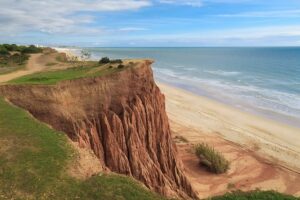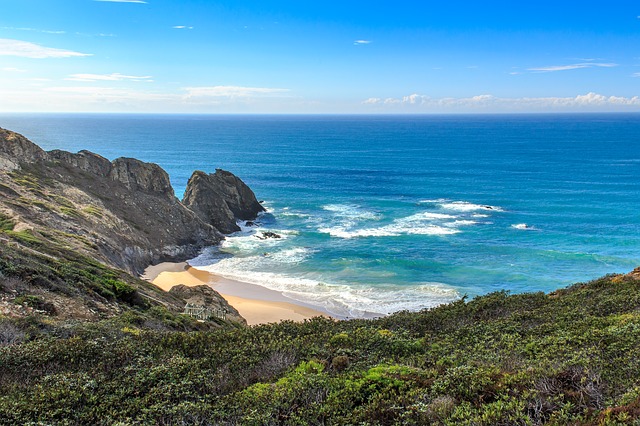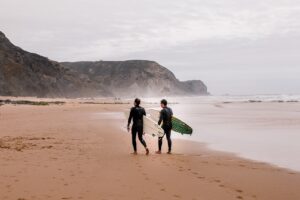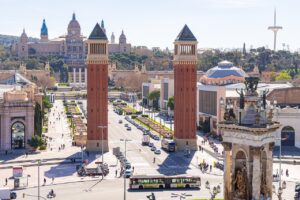Enjoying the sun on the coast of Portugal. Whether on the beach in your swimsuit, walking by the sea, with a cocktail in hand or full of action in the waves, the Algarve offers the ideal holiday experience for everyone. Due to its popularity, the Algarve is well visited, especially in the summertime. Lots of people crowd the beach, there are queues for ice cream and even for surfers it’s not always easy to find the perfect spot. This guide contains basic information about the Algarve and everything you need to know about surfing in the Algarve.
The Algarve – Information
The Algarve is located in Portugal and stretches from the southernmost surfing mecca of Portugal to the westernmost side of Europe. The coast is particularly popular among surfers, but also among package holidaymakers. The rugged natural beauty tempts everyone to take a walk. As the coastline stretches, it is also divided. There is a southern and a western side. Don’t worry, the Algarve has room for everyone. An off-road car is useful for the uneven surfaces and gravel roads. You might just find a surfing gem or two by taking the car for a spin. You can expect mild temperatures, a lively lifestyle and consistent waves all year round. Perfect for surfing!
The best surf spots in the Algarve
Generally, large crowds and long queues for surfing are to be expected, especially in summer. Many surfers, primarily beginners, want to enjoy the numerous waves in the Algarve. The good thing about the Algarve is that the waves extend all along the coast and the masses are well divided. It is also advisable for advanced surfers to visit the Algarve in winter, as the temperatures are still pleasantly warm.
The division into southern and western coast also plays a role.
The western Algarve is characterised by endless gravel roads and winding country roads with strong headwinds. Those who like it sporty and are not afraid of the wind can certainly go on a bicycle tour to explore the beaches. For everyone else, a car is best for exploring the coast. This part of the coast is well frequented in high season and small altercations between locals and tourists are unfortunately part of everyday life.
Odeceixe
Camping is forbidden here, but surfing is all the more welcome. Located at the mouth of the river, Odeceixe is the perfect spot for beginners and advanced surfers. Gentle green low and mid tide waves dance across the water. There are also surf schools there that welcome beginners with open arms or are happy to help experienced surfers hone their surfing skills.
Arrifana
Clear water, high cliffs and shelter from the wind are characteristics of Arrifana Bay. However, the beginner-friendly and wind-protected waves unfortunately get crowded very often when the north wind rages in the nearest surf spots. Nevertheless, not only is surfing fun, but watching and learning from others is also an important part of surf education. With normal weather conditions in the region, the bay is best suited for beginners.
Bordeira
Continuing along the coast, past a nature reserve offering surf spots for the more experienced, you reach Bordeira beach. Rolling hills, beach as far as the eye can see and your personal surf spot. Anyone who doesn’t find a long walk torturous can possibly discover one or two hidden spots for themselves. In normal weather, there is a suitable wave for every surfer, but should the north-west swell, south-east wind and the right sandbank meet, the take-off is only something for experienced surfers. But watch out for the dangerous rip currents!
Amado
 The long and wind-protected beach has something to offer for all surf levels. Surf schools can be found near the white water areas and there are plenty of bars for an after snack. Between the mid tide and high tide sandbanks, there is a wave for every surf level.
The long and wind-protected beach has something to offer for all surf levels. Surf schools can be found near the white water areas and there are plenty of bars for an after snack. Between the mid tide and high tide sandbanks, there is a wave for every surf level.
The south of the Algarve is characterised by red rocks, small bays and many waves. Where in the west the big waves are already too big for beginners, in the south they are just beginning. In general, the south is recommended for advanced and professional surfers. On some days, surfers are plagued by a lack of waves, as the southern part of the Algarve has no direct Atlantic swell.
Beliche
Definitely this spot is not for beginners, only if they want to watch. The waves may seem small, but they are fierce. The power of the waves is often underestimated, but the spot only reveals its true face in winter. Many surfers are just waiting for the moment to conquer the mighty waves.
Tonel
Probably the most popular spot goes to Tonel. It gets waves and sun all year round. For beginners, the low tide is ideal, which must be shared with surf schools. Mid- or high-tide is not the place to make your first surfing experiences, as hollow selections, strong currents and hidden rocks adorn the spot. Experienced surfers have priority here, but should still be careful and not underestimate the power of the waves.
Mareta
A spot that doesn’t always have waves, but is good for the environment. When the tide is low or mid, it’s worth getting on your surfboard and enjoying the waves, while when the tide is high, it’s better to put your surfboard down, as the powerful waves often crash against the cliffs as a shortbreak. Locally organised beach clean ups can be supported during such waves to counteract the littering of the ocean.
Meia Praia
With some north wind and south-east swell, it is even possible to surf without a neoprene during the summer months. Beginners and advanced surfers will definitely reach their limits with the waves. If the water is calm, you can visit the many bars, shops and restaurants.
Surfing without a wetsuit?
Surfing without a wetsuit is only suitable for advanced surfers and above. A wetsuit protects you from injuries, cold and UV rays. In good hot weather, the suit can be dispensed with, but the risk of injury remains. Because when surfing, not only the wind whips around you, but also the water. In principle, this can be possible in the Algarve as early as April.
Conclusion
The Algarve has the perfect surf spot for every surfer, no matter what level or equipment. In the west, beginners are more likely to be cavorting around and benefit from the gentler waves, while in the south, experience is called for. There are plenty of surf schools along the coast offering many courses. Bars, hotels, clubs and restaurants are of course plentiful and nothing stands in the way of a surf holiday – you might even find your own deserted, hidden surf spot.




